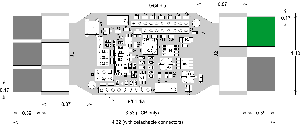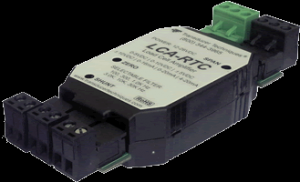Introducing the new LCA-RTC Module - Load Cell Amplifier Signal Conditioner by Transducer Techniques, LLC

CAL-TEDS Plug & Play Smart Sensors Icon

LCA-RTC Load Cell Amplifier Signal Conditioner Schematic
The LCA-RTC Module is a Load Cell Amplifier and Signal Conditioner featuring removable screw clamp terminal connectors.
TEMECULA, CALIFORNIA, UNITED STATES, April 1, 2021 /EINPresswire.com/ -- The LCA-RTC Module offers a low-cost, dedicated signal conditioning for a single bridge type load cell or torque sensor. It comes with removable screw-clamp terminal connectors, which do not require soldering. Our LCA-9PC module offers DB9 male and female connectors, which require soldering to the user-furnished mating female or male wire connectors.On-board jumper selections include sensitivities from 0.5 mV/V to 10 mV/V, bandwidths from 100 Hz to 30 kHz, and amplified outputs of 0 to ±5V, 0 to ±10V, 0-16 mA, 0-20 mA or 4-20 mA. Zero and span adjustments are via precision 25-turn low-tempco metal film potentiometers.
The LCA-RTC (Load Cell Amplifier Signal Conditioner) can be operated next to the sensor with 4-wire hookup or at distances up to 1 km (3300 feet) with 6-wire hookup. An onboard 87.325 kΩ resistor allows easy shunt calibration at the push of a button. Provision is also made for a user-furnished calibration
resistor. Power requirements are 11.8 to 26V DC with load currents from 10 to 60 mA, the latter applying when the unit provides 10V DC excitation to a 350-ohm load cell and delivers a 20 mA analog output.
Features include:
Power Requirement 12 to 26V DC
Bridge Excitation 5 to 10V DC
Bridge Sensitivity 0.5 mV/V to 10 mV/V
Push Button Shunt Calibration Network
Two-Pole Low Pass Selectable Filter 100 HZ to 30 kHZ
Analog Outputs 0 to ±5V, 0 to ±10V, 0-16 mA, 0-20 mA or 4-20 mA
Learn more facts and specifications from our website.
https://www.transducertechniques.com
Transducer Techniques, established in 1979, designs and manufactures a complete line of load cells, torque sensors, special purpose transducers and related instrumentation. Transducer Techniques load cells are uniquely designed for weight and force measurement in such diversified applications as process control and factory automation. Other applications exist in numerous fields of science and industry for our load cells. All transducer sensing elements incorporate bonded foil strain gauges, wired in a full Wheatstone bridge configuration.
Technology
Load cells are electro-mechanical transducers that translate force or weight into voltage. This change in voltage produces a signal in the read-out instrumentation, a repeatable deflection or indication that can be calibrated directly in terms of the load applied to the load cell.
Construction
Construction of the load cell utilizes all the advantages of bonded foil strain gauges. Sealed within the load cell are sets of matched strain gauges bonded to a high strength element, machined to close tolerances. The strain gauges are electrically connected to form a balanced Wheatstone bridge and additional compensation resistors are added to the circuit for maintaining the accuracy of the bridge over a wide temperature range.
Operation
The principle of operation depends upon the deflection of the strain gauge filament, creating a change in its resistance, thereby unbalancing the bridge circuit. As a result, for a given input voltage, the output voltage of the bridge varies proportionally with the load and the change can be read on appropriate instrumentation.
Quality
When completed, each load cell is individually tested and calibrated. Each cell must meet or exceed rigid electrical and mechanical performance tests before it is released for service. Also, every cell is proof tested to its full rated capacity, and in most instances, to over its rated capacity.
Attributes
An important asset of our load cells is their extremely small deflection. The maximum deflection of standard cells does not exceed .012" at full load. This plus the fact that these load cells contain no moving parts opens unlimited application fields. The inherent compactness of the load cells minimizes installation problems.
The frequency response characteristics of our load cells are exceptionally good. The relatively low mass, and the small deflection under load, result in a high-frequency response which emphasizes the use of the load cells in many services where other transducers cannot perform.
Only strain gauges of the highest quality are installed and configured by technicians who have undergone our extensive training program targeting craftsmanship and attention to detail. To the end-user, this means a quality product. All Load Cells / Force Sensors and Torque Sensors are supplied with a Calibration Certificate traceable to NIST.
Customer Support
Transducer Techniques, LLC
+1 800-344-3965
email us here
Visit us on social media:
Facebook
Twitter
Legal Disclaimer:
EIN Presswire provides this news content "as is" without warranty of any kind. We do not accept any responsibility or liability for the accuracy, content, images, videos, licenses, completeness, legality, or reliability of the information contained in this article. If you have any complaints or copyright issues related to this article, kindly contact the author above.

